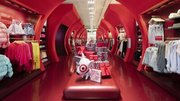Article
The psychology of retail marketing
From rounded corners to natural textures: Neurological research reveals why consumers react the way they do to the in-store experience.

August 23, 2010
It’s a jungle in there. Literally, from the brain’s point of view, when your customers walk into your store, regions of their brains react the same way they did when our ancient predecessors made their dangerous progress across the Serengeti. In this sense, shopping is very serious business, requiring survival skills developed over thousands of years.
For example, what would you guess would alarm the subconscious, setting off a 100,000-year-old internal warning system as you wander the aisles?
The answer is something as common as an end cap. It triggers what neuroscience describes as an avoidance response deep within the subconscious. The sharp edges of the metal shelves pose a potential threat —just as the sharp tip of a branch would on the savannah. Shoppers could be blinded, cut, perhaps bleed to death.
 |
| This article is an excerpt from "The Buying Brain: Secrets for Selling to the Subconscious Mind," written by Dr. A.K. Pradeep and reprinted with kind permission. |
Ridiculous in today’s world? Of course, but the brain still registers the danger and responds accordingly. It alerts the body to the subconsciously perceived threats and directs shoppers to avoid them.
The brain is geared, from evolution’s millennia, to seek out and protect you from the dangers that lurk around you. That sharp corner—of the end cap or your kitchen cabinet—represents just such a threat, and your brain cannot help but react instantaneously, and subconsciously, to avoid it.
The brain dislikes straight lines and sharp edges. Where possible, avoiding incorporating sharp lines in a store setting makes the experience much more pleasing to the brain.
In many studies across categories and retailers, we have found display devices with rounded edges to have greater levels of neurological effectiveness, and shelf dividers known as “blades” with rounded edges to outperform regular linear dividers. The lesson here is to remove the perceived threat that sharp edges present, and the uber-watchdog, that 24/7 sentry sitting atop your shoulders—your subconscious mind—will relax and be happy.
This principle was confirmed in a recent study for another food manufacturer. Here’s what we did, and what we discovered:
- Variables tested: three aisle designs (one with rounded edges)
- Gender map: 50 percent male and 50 percent female
- Findings: the design with rounded corners significantly outperformed the other two designs. Rolling this out in test markets resulted in a significant increase in sales—15 percent. That’s how much the brain likes rounded edges.
What else prompts your subconscious to respond when you’re roaming the retail range?
Our in-store studies have revealed another intriguing fact. It appears the brain prefers natural textures. The exact same aisles with the same products and features with alterations in textures performed significantly differently, the key learning being natural textures seem to evoke a deep emotional response in the brain. We humans are creatures of nature, and as such, we are neurologically oriented to find the sight, feel, scent, and even the sound of things like wood, grass, leaves, and water familiar, comfortable, and inviting.
The subconscious can be “fooled” to a limited degree, though. For example, plastic representations of wooden surfaces can substitute for the real thing, if executed authentically and plausibly.
Subconscious Signals
Ever stood in front of a whole drugstore shelf full of toothpastes and felt a certain ennui? Pondering which to choose: paste or gel, whitening/brightening/cavity-preventing, mint or wintergreen-flavored, white, striped or aqua, seemingly ad infinitum? If you have, it’s because of a fascinating neurological phenomenon called repetition blindness.
Essentially, some of your subconscious mind tends to “check out” temporarily when confronted with too much of one thing. (Even a good thing!)
Repetition blindness occurs when your frontal cortex has to process an array of similar visual images all streaming in from the visual cortex. Coming back to our dental health example, when your brain “sees” box after box of identically-shaped toothpaste packages, lined up in row after row, many sporting very similar colors, logos, words, and images … well, a portion of your subconscious brain takes a kind of mini-holiday.
“Too much, too identical, can’t differentiate, no novelty,” it tells itself. And the result is that your subconscious perceives the wall of toothpastes as a sort of big blur. That’s because we’re neurologically programmed to search for differences. To seek out things that enable us to make sense out of the environment we find ourselves in and to navigate our world safely and productively. When the brain is presented with a series of repetitive images—even if there are some differences among them—repetition blindness sets in. The brain no longer “sees” each individual image as it would if that image stood alone, or with only a small number of similar/identical images.
Ultimately, of course, the brain reasserts itself and makes sense out of what it sees—if it didn’t, we might all be stuck in the health and beauty aids section forever, staring at the sea of Crest and Colgate before us. As it does in so many other instances large and small, critical and minimal in scale and importance, the frontal cortex takes command, and we reach out, pluck the toothpaste of choice off the shelf, and plunk it into our cart.
The retailer’s solution is to stagger carefully such displays, both in depth and height.
We were blind, but now we see.
Marketing Magnets
Has a clever consumer products company realized that your brain is drawn, magnet-like, to human faces? If so, is there packaging or a piece of merchandising material nearby that depicts a friendly visage?
Advantage, neuromarketer.
Neurologically, we are designed to focus on faces. They are our windows into what may lie in store for us: danger or affection, trust or treachery. A face nearly always ranks highest on the brain’s list of things to monitor.
So, feature faces every way you can, because by doing so you are playing directly into something very central to the brain, and it will reward you with its concentration and the precious gift of assigned cognitive resources.
The Measured Miles: In-Store Neurological Testing
Apart from these best practices, neuroscience offers the opportunity to test how shoppers react – deep within their subconscious – to your unique store environment. There are three ways to measure the brain’s responses to the actual shopping experience.
1. In-store EEG testing
One of the great advantages of EEG-based neurological testing is the fact that the equipment is easily adapted for portability/mobility. We can capture the same brainwave activity in the linguini section as we do in the laboratory. A test subject can stroll the aisles and shop just as she normally would. All the while, EEG sensors acquire brainwave activity at 2,000 times a second, across multiple regions of the brain, and that data is recorded on a portable hard drive for processing and analysis.
Simultaneously, eye-tracking equipment captures the shopper’s precise focal location, enabling the brainwave data being gathered to be matched with exactly what she was looking at, at any given millisecond.
But what if, for any number of reasons, there is a need to measure shoppers’ neurological responses outside the actual store environment? Perhaps it’s a need for repeated passes down a number of aisles. Perhaps it’s because a client wishes to alter certain aspects of the shopping experience, to determine consumers’ different reactions, and to attempt to do so with real shoppers in a real store setting would be prohibitively time-consuming/expensive.
In those circumstances, there is an alternative:
2. Video Realistic Technology
Digital technology has advanced to the point where the in-store shopping experience can be replicated, with startling realism, without a test subject ever stepping foot inside an actual store.
Video Realistic methodology allows subjects to push a virtual shopping cart down virtual aisles, all the while scanning virtual products on virtual shelves. But the technology doesn’t stop there. Shoppers can pause and pick up products, examine them on all sides, and replace them on the shelf. The high-definition video codec enables a subject to read the fine print on a label, experience the rich colors of the packaging, or see the smile on the face of the infant on the bottle of apple juice.
It is a fully immersive shopping experience, without the store. The brain responds in the same fundamental ways that it would in an actual retail setting. From a neurological perspective, the stimuli are much the same: the aisle looks real, the shelves are stocked, and the package looks like a real package. Everything is in the correct scale. Even other shoppers are in place (from the brain’s perspective, this is an important ingredient in the testing scenario, because the subconscious prefers as "naturalistic" a setting as possible).
The tactile sense is not the same—the subject doesn’t feel the weight of the package, for example—but for most market research purposes, that exception isn’t mission-critical.
The flexibility of Video Realistic is one of its greatest virtues. Store environments can be changed with a few keystrokes. Packages can be moved, substituted, altered in any way desired. Displays can be changed, signage can be shifted—this attribute and others makes Video Realistic a very viable alternative, and increasing numbers of marketers are discovering its value.
3. 3D Matrix
Fresh out of our laboratories is a technology we call N-Matrix 3D. In the post-
“Avatar” world, 3D is becoming more and more the norm for the consumer experience, and therefore increasingly so for the market research field. N-Matrix 3D enables our test subjects to experience startling levels of perceived reality, and the neurological benefits are research results that are more accurate and reliable than other virtual reality testing methodologies.
Future Shopping
What can neurological testing tell us about the future of retail, and in-store marketing? There are lines that we can draw out over the horizon, starting with what we know about the brain and how it functions—what it likes and doesn’t like.
We know the brain delights in novelty. As humans, we are predisposed to seek out the new. So retail environments could benefit from fresh designs, new applications of lighting, sound, and textures, innovative ways of presenting merchandise. For example, we know that the brain dislikes straight lines—so a creative retailer might decide to design a store setting that emphasizes curves rather than hard angles.
We know that the brain prefers natural textures over artificial textures. Technology is likely to bring us advances in synthetic materials that almost perfectly mimic their real, organic sources of inspiration.
My prediction is that as marketers and retailers become more knowledgeable about full brain, EEG-based neurological testing, more aware of how consumers actually make purchase decisions, and realize neuromarketing’s potential to deliver the most precise insights into that process and others, they will harness the power of neuromarketing methods for competitive advantage.
Reprinted by permission of the publisher, John Wiley & Sons, Inc., The Buying Brain by A.K. Pradeep. Copyright (c) 2010 by John Wiley & Sons, Inc. All rights reserved.






